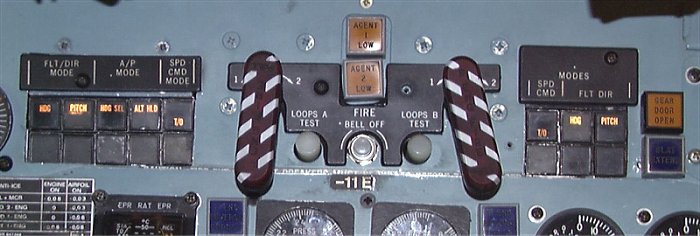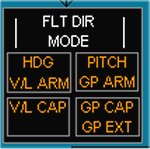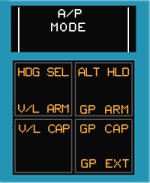MODE ANNUNCIATOR.

This is the Mode Annunciators of the DC9. There are three different annunciators.
On the left side Flight Director, Autopilot and Speed Command. On the right side only
Speed Command and Flight Director.
In the aircrafts from this time, the FMA does not play that significant role in
the handling of the system as in the modern cockpit. In the DC9 every change in
the autoflight system is accompanied by a sound. The switches will always click.
It is possible to be aware of what the other pilot is doing, even with your eyes closed.
The modern cockpit is silent, most everything is electronically controlled.
 Flight Director.
Flight Director.
HDG and PITCH is on with the FD in F/I.
V/L ARM and GP ARM is on with the FD in RADIO AUTO until LOC/GP capture.
V/L CAP and GP CAP is on after capture of LOC/GP.
GP EXT is on when the GP extension has been initiated by the radio altimeter.
The sensitivity of the A/P glide path signal is reduced close to the ground (
below 1000ft).
 Autopilot.
Autopilot.
HDG SEL is on when HDG SEL switch is in ON position. ALT HLD is on
when the vertical speed wheel is in ALT HOLD position.
V/L ARM and GP ARM is on when the A/P is armed for capture of
VOR/LOC or GP beam.
V/L CAP and GP CAP is after capture of LOC/GP.
GP EXT is on when the A/P is in the glide path extension mode.
 Speed command.
Speed command.
TO Take Off is activated when the aircraft is on ground for at least 4
seconds.
APPR Approach mode can only be obtained in flight. Mode switching will
take place when the throttles are retarded behind a "diamond" marking on the
throttle position scale (approx 60%).
GO ARD Go Around can only be obtained in flight with FD in G/A mode.
SPEED COMMAND SYSTEM.
There are two independent speed command systems. They work in three different
modes, takeoff (TO), approach (APPR) and go-around (GO ARD). Mode switching is
automatic except go-around which must be selected. The computer determines
a safe speed above stall based on the actual inputs from angle of attack, longitudinal
acceleration, pitch attitude, pitch rate and flap/slat configuration. Deviations
from computed speed are displayed on the fast-slow indicator in the FD horizon.
T/O and GO ARD speed schedules are identical.
In T/O and GO ARD modes, deviation is also displayed as commands by the FD
horizon pitch command bar, provided FD is in G/A.
On ground, the angle of attack sensors may assume different positions due to
wind and friction. Difference in speed commands may thus occur and the SPEED
comparator light may be on during the first part of the takeoff roll. The angle of
attack sensors will be streamlined before aircraft rotation.
|

 Flight Director.
Flight Director. Autopilot.
Autopilot. Speed command.
Speed command.